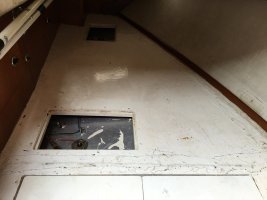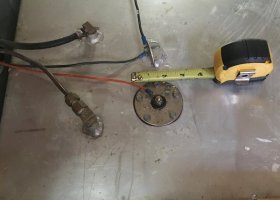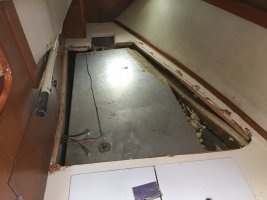I have exposed the 50-gallon fuel tank in the E38 quarterberth. Interesting that the lid is too wide to fit through the companionway. And, in addition to being screwed down (it forms the surface of the after berth), the seam was then glassed over with 4" fiberglass tape by the factory--screwheads and all. A stick of gum to anybody who can deduce the reasoning behind that that tape.
So, regarding the installation of inspection ports:
1. How best to transfer about 40 gallons of fuel off the boat? Jeff Asbury used a simple drill pump. Anybody else? (I plan to discard the ancient fuel, not try to polish it).
2. I plan to cut inspection ports openings with a jig saw. Or a sabre saw, as Glyn did. The tank wall is 3/16ths aluminum.
3. What port closures? I'm considering simple 8" aluminum plates over 6" round holes, with appropriate gaskets. (Instead of the $200/each Seabuilt fittings, of which I'd need 3.)
4. Attaching the plates. My fuel sender port is about 2" diameter, and the sender and gasket are held down by aluminum sheet metal screws. It doesn't leak.
I don;t see why that method shouldn't work for the inspection ports, too. Lots of screws, maybe every inch around the plate perimeter.
The screw holes would would be tapped, if possible. I don;t know if 3/16ths provides enough material for tapping.
Teh screws method works for the sender, so why not for the plates too?
5. There exist articles warning that sawing aluminum into a diesel tank is dangerous, and to be avoided. I don;t find them persuasive, and many have done it.
Ideas and opinions appreciated.
Christian
One useful thread http://www.ericsonyachts.org/infoexchange/showthread.php?10330-Fuel-Polishing-ASAP/page6
So, regarding the installation of inspection ports:
1. How best to transfer about 40 gallons of fuel off the boat? Jeff Asbury used a simple drill pump. Anybody else? (I plan to discard the ancient fuel, not try to polish it).
2. I plan to cut inspection ports openings with a jig saw. Or a sabre saw, as Glyn did. The tank wall is 3/16ths aluminum.
3. What port closures? I'm considering simple 8" aluminum plates over 6" round holes, with appropriate gaskets. (Instead of the $200/each Seabuilt fittings, of which I'd need 3.)
4. Attaching the plates. My fuel sender port is about 2" diameter, and the sender and gasket are held down by aluminum sheet metal screws. It doesn't leak.
I don;t see why that method shouldn't work for the inspection ports, too. Lots of screws, maybe every inch around the plate perimeter.
The screw holes would would be tapped, if possible. I don;t know if 3/16ths provides enough material for tapping.
Teh screws method works for the sender, so why not for the plates too?
5. There exist articles warning that sawing aluminum into a diesel tank is dangerous, and to be avoided. I don;t find them persuasive, and many have done it.
Ideas and opinions appreciated.
Christian
One useful thread http://www.ericsonyachts.org/infoexchange/showthread.php?10330-Fuel-Polishing-ASAP/page6



